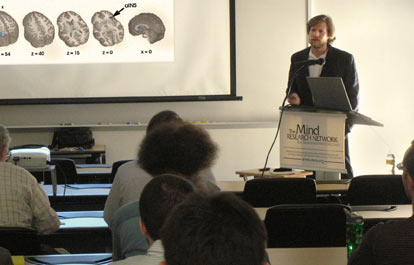

Scientific Lectures //
Connectivity of the Striatal Resting-State Networks on Autism Spectrum Disorder
Thomas DeRamus, PhD, Department of Psychology, University of Alabama at Birmingham
Presented: November 13, 2017
ABSTRACT: Social deficits and repetitive behaviors and are core features of autism. Structural and functional alterations in the striatum, brain regions highly involved in movement planning, regulation, and motivation, may underlie these core features. However, few studies have examined functional connectivity (FC) of the striatum in autism; and fewer have examined anatomical connectivity despite hypotheses of structural alterations influencing FC autism spectrum disorders (ASDs). To address these gaps, the current study examined FC of resting-state brain networks in the striatum in 19 typically developing and 19 children with autism (ages 7-17 years) from the Autism Brain Imaging Database Exchange II. The approach is unique in that it compares the traditional group analysis to a behavior-centric focus on repetitive behaviors and social motivation. These analyses were expanded upon using diffusion weighted imaging (DWI) measures of connectivity to ex-amine the degree to which anatomical connectivity correlated with FC in the brain.
ASD participants displayed increased striatal-cortical FC in sensorimotor and de-fault mode networks, but also striatal-cortical FC reductions in frontoparietal, dorsal at-tention, and default mode networks. Measures of social motivation were found to corre-late with striatal-cortical FC in dorsal attention networks, while measures of stereotyped and compulsive behaviors were found to correlate with FC in sensorimotor and frontopa-rietal striatal-cortical networks respectively. FC between striatal and cortical regions typ-ically associated with reward processing did not correlate with social motivation scores, in contrast to theories proposing dysfunction within these regions in ASD.
Very few anatomical connections were correlated with FC, and those that did were lim-ited to default mode or frontoparietal networks that were not related to the initial TD vs ASD contrast or the behavior analysis. More data is needed to assess the influence of structural connectivity on functional connectivity given the constraints of the model used. The findings of this study seem to suggest that while there may be alterations in the stria-tum in ASD, those differences may be pronounced in brain regions associated with atten-tion and cognitive control. Future work using behavior-and-anatomy-centric analyses in ASD may provide more insights into useful information processing models in a disorder where behavior is highly variable.
To view this presentation please click here.

